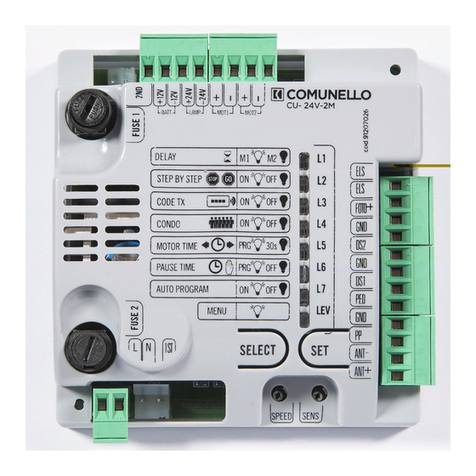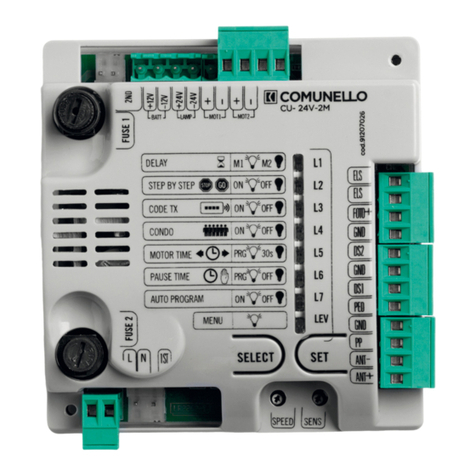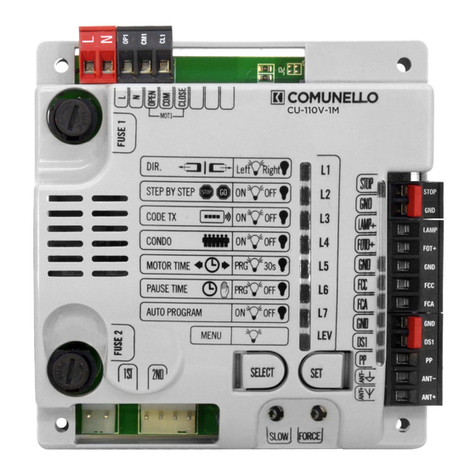
16 COMUNELLO ®Copyright 2016 - All right reserved
OPERATION WITH TIMER:
The control unit allows a timer to be connected in place of the open – close
pushbutton. E.g.: at 08.00 am the timer closes the contact and the control
unit commands an opening movement; at 06.00 pm the timer opens the
contact and the control unit commands a closing movement. From 08.00
am - 06.00 pm at the end of the opening cycle the control unit disables the
ashing light, automatic closing and the remotes.
PROGRAMMING:
SELECT key: selects the type of function to store; the selection is indicated
by blinking of the LED.
Press the key repeatedly to go to the required function. The selection
remains active for 10 seconds shown by blinking of the LED; when this
interval elapses, the control unit returns to the original state.
SET key: programs the information in accordance with the function type
preselected with the SEL key.
IMPORTANT: The SET key function can be replaced by the remote if
programmed beforehand (CODE LED on).
Programming enabled only when safety devices are not active.
MAIN MENU
The control unit is factory set to allow the selection of several important
functions.
L1 DIR Left Open Right Open
L2 STEP BY STEP Step-by-Step Automatic
L3 CODE TX Code entered No code
L4 CONDO ON OFF
L5 MOTOR TIME Programmed time 30 sec.
L6 PAUSE TIME With automatic closing Without automatic closing
L7 AUTO PROGRAM ON OFF
LEV MENU ON
1. OPENING DIRECTION (DIR):
In the default conguration the control unit is set with “OPEN TO RIGHT”
logic (seen from the operator side, with operator installed to the right of
the sliding leaf); if the “OPEN TO LEFT” logic must be enabled (seen from
operator side, with operator installed to the left of the sliding leaf), proceed
as follows: use the SELECT key to select the blinking OPEN DIRECTION
LED and then press the SET key: the OPEN DIRECTION LED becomes
steady on and programming will be completed. Repeat the procedure if you
wish to restore the previous conguration.
2. STEP-BY-STEP:
In the default conguration the control unit is set with “Step-by-Step”
operating logic enabled (LED n2 on); if the “Automatic” operating logic is
required (LED n2 on), proceed as follows; use the SELECT key to select
blinking LED n2 and then press the SET key: LED n2 will switch off and
programming will be completed.
If the “Step-by-Step 1” operating logic is required, repeat the operation
above described, by pressing the SEL key twice instead only one (to obtain
the quick blinking of LED .
Repeat the procedure if you wish to restore the previous conguration.
3. TX CODE: (REMOTE CONTROL CODE)
Up to 120 remotes with different codes, either of the xed or the rolling
code type can be saved on the control unit.
Programming:
Programming of the transmission code is performed as follows: use the
SELECT key to select blinking LED L3. Press SET once; the LED will change
its blinking mode (longer 1 0 1 0) to show that the rst level is being saved.
On sending the selected code with the required remote, the CODE LED
will remain steady on to indicate that programming has been completed.
To save the code for pedestrian opening / single leaf proceed as follows:
use the SELECT key to select blinking CODE LED L3. Press SET twice
consecutively; the LED will change its blinking mode (1 1 0 1 1 0) to show
that the pedestrian code is being saved. On sending the selected code
with the required remote, CODE LED L3 will remain steady on to indicate
that programming has been completed.
NOTE: After each programming of a valid code, the control panel
waits for a subsequent code for another 10 sec.
If all 120 codes have been saved, repeating the programming operation will
cause all the programming LEDs to start blinking to signal that no further
codes can be saved.
Deletion.
Use SELECT to go to LED L3; activate blinking of the code to be deleted
(CODE or PEDESTRIAN identied by the respective blinking); press and
hold down SET for > 5 s. After this interval the LED will switch off for 2
seconds and the procedure is completed. If all CODE and PEDESTRIAN
codes are deleted, the LED will remain off.
If only PEDESTRIAN codes remain stored, the LED blinking mode will
change (1 1 1 1 0 1 1 1 1 0)
Rule of the rst saved Remote control:
When programming remotes the following rule is applied: if the rst remote
to be saved is of the rolling code type, the receiver will subsequently
accept only rolling code remotes, thus providing enhanced anti-intrusion
security; if the rst remote to be saved is a xed code type, the receiver will
subsequently accept both xed code remotes and rolling code remotes,
although only the xed part of the latter will be controlled (thus effectively
relinquishing the security of the rolling code system).
IMPORTANT: Whenever a reset is performed the receiver is restored to the
factory settings so the rst remote rule logic will be reset.
4. CONDO:
The Condominium function means that during the opening movement or
during the pause time the control unit will not respond to commands sent
by Pushbuttons or remotes. In contrast, during the closing movement a
command sent by the Pushbuttons or the remotes will reverse the direction
of movement. This operating mode is invaluable when the automation
includes a loop detector. In the default conguration the control unit is set
with the Condominium function disabled; if the Condominium function is
required, proceed as follows: use the SELECT key to select blinking LED L4
and then press the SET key: LED L4 becomes steady on and programming
will be completed. Repeat the procedure if you wish to restore the previous
conguration.
5. MOTOR TIME:
(Programming of the motor run time with max 4 minutes). The control unit
is factory set with a preset motor time of 30 seconds without deceleration.
If motor time must be changed, programming must be carried out with the
gate closed as follows: use the SELECT key to select blinking LED L5 and
then press the SET key momentarily; the operator will start the opening
movement; when the required deceleration starting point is reached
press the SET key again; at the same time the operator will decelerate
and reach the required position; press SET to terminate the opening cycle.
Thereafter LED L5 will start blinking rapidly; now repeat the motor time and
deceleration programming procedure for the closing cycle. If you do not
require the control unit to perform the deceleration, during programming,
when the open-close cycle has been completed press the SET key twice
consecutively rather than just once. During programming, instead of the
SET key on the control unit you can use the button on the remote, providing
the remote has been saved beforehand.
6. PAUSE TIME:
(Automatic closing time programming 4 min. max.) The control unit is
factory set with automatic closing disabled. If you wish to enable automatic
closing proceed as follows: use the SELECT key to select blinking LED L6
and press the SET key momentarily; now wait for a time equivalent to the
required time; press the SET key again momentarily and at the same time
the automatic closing time will be saved and LED L6 will remain steady on. If
you wish to restore the initial condition (no automatic closing) select blinking
LED L6 and then press the SET key twice consecutively in a time period
of 2 seconds. The LED will switch off and the operation will be completed.
During programming, instead of the SET key on the control unit you can use
the button on the remote, providing the remote has been saved beforehand
7. AUTO PROGRAM:
The control unit offers the facility of Automatic Programming (SIMPLIFIED).
First bring the gate leaves to an intermediate position, use the SELECT
key to select blinking LED L7 and then hold down the SET key; the control
unit executes the Auto programming procedure by performing a complete
open-close cycle (keep the SET key pressed until Auto Programming is
completed). During the Auto Programming procedure the Deceleration
cycle is set automatically at approximately 15% of the complete cycle.
During Automatic Programming, instead of the SET key on the control unit
you can use the button on the remote, providing the remote has been
saved beforehand.




































